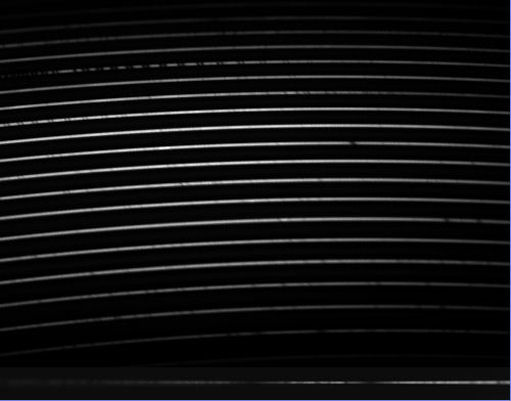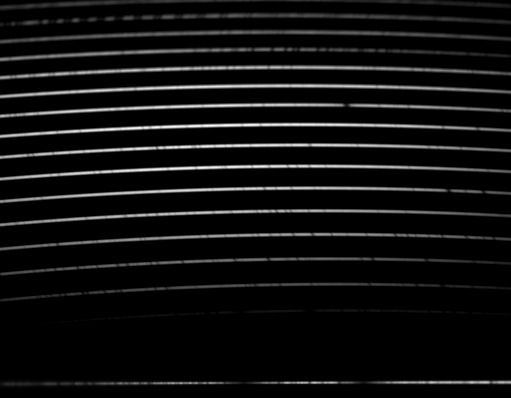The Solar-Stellar Spectrograph
[ Home | About | Tech Info & Data | Publications | References ] [ Site by Jeffrey Hall | Research funded by NSF ]
Overview of CCDs and data format
1993-2007 data
The SSS was built in the 1980s and we used the original equipment through the end of 2007. In early January 2008, a power glitch caused by a heavy snowstorm caused a failure in the Q-bus readout electronics. This was certainly not the first problem we had with the system, but it was the ninth of the old system's lives. Thus, we have two raw data formats in our archive.
In their useful characterization of data as the good, the bad, and the ugly
(Massey & Jacoby 1992),




"CCD Data: The Good, The Bad, and The Ugly." ASP Conference Series #23 (San Francisco: ASP), 240. [Excellent discussion of the pitfalls of CCD data reduction.] the 1993-2007 SSS data may be fairly likened to Quasimodo: beautiful on the inside, but it surely takes some effort to see that. The upside to our long-term usage of the same instrumentation is continuity of the time series; the downside was the age and quality of the CCDs, which were TEK 512s with 42 electron read noise.
Post-2007 data
Our present grant (January 2008 - January 2011) provided money to replace the cameras, CCDs, and data acquisition software. This was a much-needed upgrade; although the folks at HAO built the hardware very well, it was quite rickety after nearly 20 years of use and duly died within days of the start of our 2008-2011 grant. We suspended observations following failure of the acquisition electronics. After the typical delay associated with identifying the necessary new components, ordering them, getting them built and shipped, rebuilding the spectrograph back end, and troubleshooting, we installed two iDus CCD cameras from Andor in July 2008.
Arrangement of the spectrograph and CCDs

A picture of the SSS case is shown at right, with major components labeled. This was taken before commissioning; in normal operation the facility has a heavy triangular lid, and the fiber carrying sunlight, starlight, and flat field and Th-Ar light is plugged in at bottom right. The silver base is isolated from the rest of the case and sits about four feet off the floor. We call the whole unit "the coffin."
As you can see, the SSS comprises two spectrographs. The first optical element is a dichroic beamsplitter that directs the HK spectrum to the "blue" spectrograph (a single-order Littrow configuration) while passing optical light to the "red" spectrograph (an echelle with prism cross-disperser).
We have made a few adjustments since installation of the coffin at Lowell in 1988. We have had to repair broken optical fibers twice, and have had to make repairs to the thermoelectric cooling system for the red spectrograph. In 1993, we installed a light pipe just above the echelle; the beam slightly overfills the grating and we pick off some of the overflow to feed an exposure meter, ensuring maximum throughput.
As noted above, just after New Year's Day in 2008, the readout electronics for both cameras were destroyed by a power fluctuation during a heavy snowstorm. This was not a disaster, since the cameras and CCDs were in need of replacement anyway, and we had secured funding to purchase two new cameras. Therefore, in early 2008, everything downstream of the gratings and prism was be removed and replaced with a new, turnkey system.
Raw Data Frame [1993-2007 data]

In the 1993-2007 data, the two 512x512 CCD frames are cropped and combined into a single 512x400 frame that contains the 19 usable orders from the echelle and the single HK order. The arrangement of the frame is shown at right with essential spectral features indicated.
The echelle images orders 25-43 on the red CCD with 70% spectral coverage ranging from λ9000 Å in order 25 (at top) to λ5100 Å (at bottom). This advantageously covers a number of important chromospheric proxies, but also suffers from heavy telluric blending through most of the orders. Order curvature and increasing separation to the blue is of course a result of the prism cross dispersion.
The "blue" spectrograph covers a single order spanning λλ 3860-4010 Å. The K and H lines are clearly visible roughly where indicated.
Resolution of the instrument is approximately 12000. We monitor the CCD background using bias frames as well as areas of the data frames with no signal, indicated by blue and red boxes.
The raw data are 14-bit integers, yielding dynamic range in ADU from 0 to 16,383. Typically, we aim for 10,000-12,000 ADU in our flat field frames and solar exposures. Observations of stars of V~6.0 yield ~700 ADU at the echelle maximum in a 10-minute exposure, which translates to a theoretical maximum S/N in the entire spectrum of ~150, and typically 20-30 in the K line core. In practice, high-frequency noise in the electronics reduces the actual S/N, though we are able to remove it with a low-pass filter (described elsewhere on this site).
Raw Data Frame [Post-2007 Data]

Our goal during the camera replacement was to replicate the former spectral format as much as possible for contintuity of the data series. Toward this end, we use new CCDs with similar dimensions and pixel size as the previous ones. The HK spectrum recorded by the new Andor cameras is almost identical to the old one. The field of view and pixel scale in the echelle frame is slightly smaller and there is a significant focus rolloff in the far red, so there are fewer usable orders than in the old data. Therefore, rather than pushing the extraction all the way to 9000 Å in order 25, we stop at 7600 Å in order 29. We do lose coverage of the calcium infrared triplet, but otherwise the spectrum in this area is heavily polluted with telluric lines. Our principal region of interest is 5000-7000 Å, and we have optimized the positioning and focus in the new echelle spectrum for this spectral region.
The "old" SSS data frames were well positioned on the CCDs; there is not much well-exposed spectrum beyond the boundaries of the chips (due to falloff in both the fiber transmission and the echelle blaze function), so our post-2007 raw data frames have dimensions of 512 x 400 pixels, identical to the 1993-2007 data. However, since we extract spectra from the new frames redward only to order 29 rather than order 25, the post-2007 reduced spectra have dimensions of 512 x 16 rather than 512 x 20.
The new raw data are 16-point floats, yielding dynamic range in ADU of 1 to 65,535.
Preparation of data for reduction
Our IDL routines preprocess_solar and preprocess_stellar convert raw SSS data frames into a format suitable for reduction, and it is the first step applied to the data. All raw data frames, of any type, are processed identically, and in the following manner:
1. Rotation: The raw data appear with the orders running vertically. To optimize the frames for processing with IDL, the frames are rotated so that wavelength increases upward and to the right (in both cases varying directly with IDL array index).
2. FITS header creation: The SSS data reduction object contains routines that extract information from the electronic log and format it in a standard one-unit (2880-byte) FITS header.
3. Data setup and storage: The routine ensures the raw data are big-endian, in accordance with the FITS standard. The header and associated raw data are then grafted and stored using custom FITS reading and writing routines.
Raw data frames may be either of integer or floating-point type. The resulting frames are either 403K or 803K. Only minor adjustments to the routines were necessary to enable them to handle both the "old" (1993-2007) and "new" (post-2007) data formats.
[Back to contents]
[ Back to my home page | Email me: jch [at] lowell [dot] edu ]
The SSS is publicly funded. Unless explicitly noted otherwise, everything on this site is in the public domain.
If you use or quote our results or images, we appreciate an acknowledgment.
This site is best viewed with Mozilla Firefox.